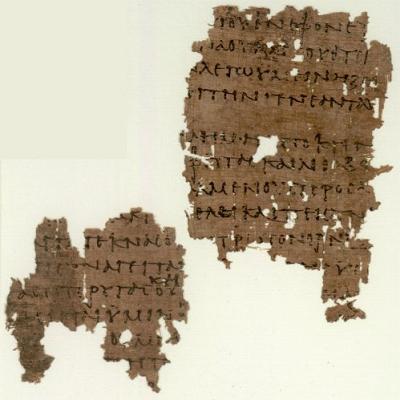| Change to Book/Chapter View |
|
|
|
Translation process is ongoing. For current status see details |
|
|

Papyrus 77 Discovered: Oxyrhynchus, Egypt Location: Oxford, England; Ashmolean Museum Contents: Matthew 23:30-39 Notes: This papyrus is likely to be from the same manuscript as Papyrus 103.
Matthew 23 30 and say, ‘If we had lived in the days of our fathers, we wouldn’t have been partakers with them in the blood of the prophets.’ 31 Therefore you testify to yourselves that you are children of those who killed the prophets. 32 Fill up, then, the measure of your fathers. 33 You serpents, you offspring of vipers, how will you escape the judgment of Gehenna? 34 Therefore, behold, I send to you prophets, wise men, and scribes. Some of them you will kill and crucify; and some of them you will scourge in your synagogues and persecute from city to city, 35 that on you may come all the righteous blood shed on the earth, from the blood of righteous Abel to the blood of Zachariah son of Barachiah, whom you killed between the sanctuary and the altar. 36 Most certainly I tell you, all these things will come upon this generation. 37 “Jerusalem, Jerusalem, who kills the prophets and stones those who are sent to her! How often I would have gathered your children together, even as a hen gathers her chicks under her wings, and you would not! 38 Behold, your house is left to you desolate. 39 For I tell you, you will not see me from now on, until you say, ‘Blessed is he who comes in the name of the Lord!’”
|
How to read these pages: • The
translation to the left is based on the World English Bible. Words in regular
black font are words in the manuscript matching the Majority Text for that
passage. • Words
in italics cannot be seen in the manuscript, since the manuscript is
fragmentary. These words are supplied for readability by the World English
Bible translation. • Words
present in the manuscript but with some letters unreadable or missing are in blue
like this: blue. One Greek word often is
translated into multiple English words, and when this occurs, all the English
words are in blue. • Words
present in the manuscript but with spelling or trivial word order differences that do not affect the
meaning are in green like this: green. • If
the manuscript is different from the Majority Text, words in the Majority
Text that are missing from the text of the manuscript are marked through in red
like this: • If the manuscript is different from the Majority Text, words in the manuscript that are not in the Majority Text are underlined in red like this: new words.If the manuscript differs from the Majority Text yet matches another well-known text, this is noted in the footnotes.
|
